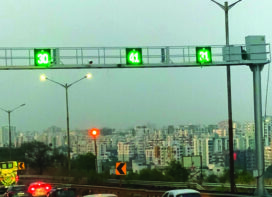IoT and “Big Data”
 The railway environment generates a vast amount of “Big Data” from many interconnected stakeholders which can be used to improve passenger safety and the efficiency of station and freight operations.
The railway environment generates a vast amount of “Big Data” from many interconnected stakeholders which can be used to improve passenger safety and the efficiency of station and freight operations.
Onboard control and monitoring systems turn trains into interconnected communication hubs, transmitting data among themselves and to network control centres, from which they also receive instructions.
Safety is a primary element of IoT applications in train energy management. For example, onboard train location and detection systems enable trains to be “aware” of the positions of other trains, reducing the risk of collisions while allowing trains to operate safely in close proximity to one another. Speed monitoring and control are other important safety applications.
The multinational company Siemens, which runs various smart train programmes in Europe and the US, says the billions of data points from sensors and software platforms can be harnessed to “reduce unplanned downtime, improve operational efficiency, enable improved business planning and performance and generate energy and cost savings”. More effective and predictive maintenance is another major benefit.
Data sources include not only sensors on trains and trackside infrastructure but also station ticket gates and kiosks, video surveillance, car parks and monitors in buildings and freight yards.
Sensors – closely observed trains
Sensors used in signalling, control and protection applications play a major part in enhancing the safety and reliability of railway operations.
Thousands of sensors embedded in systems and components on trains can detect a broad range of individual parameters such as location, vibration, speed, direction, pressure and temperature. These sensors provide information about the wheel rail interface as well as onboard equipment.
For example, accelerometers based on microelectromechanical systems (MEMS) that monitor vibrations in train axles can detect potentially dangerous anomalies in the rails. Vibration data can also indicate signs of wear on bearings and wheels, and signals can be sent automatically via the IoT to notify train operators that components need replacing. Sensors in doors can indicate their level of wear and tear and whether they are able to close safely and within an acceptable timeframe. Trackside sensors contribute other vital data on the temperature and safety of tracks, embankment stability and the condition of bridges and other infrastructure.
SNCF, France’s largest railway operator, is using thousands of sensors to equip a network covering 30 000 km of track, 15 000 trains and 3 000 stations. SNCF’s latest Paris commuter trains are fitted with 2 000 sensors, which forward 70 000 data points per month. This enables engineers to monitor up to 200 trains at once remotely for potential problems including door or air conditioning failures, while the trains remain in operation.
IEC International Standards produced by a range of IEC TCs and SCs cover MEMS and other sensors, with an emphasis placed on safety and interoperability.
IEC TC 47: Semiconductor devices, and its SC 47F: Microelectromechanical systems, are responsible for compiling a wide range of International Standards for the semiconductor devices used in MEMS and other sensors such as accelerometers and temperature and pressure sensors.
Predictive Maintenance
 The ability to predict when maintenance is needed reduces costs and means that it can be carried out when trains are not required to be in service, so minimizing disruption to the network.
The ability to predict when maintenance is needed reduces costs and means that it can be carried out when trains are not required to be in service, so minimizing disruption to the network.
Predictive maintenance of rolling stock and tracks involves using data to make informed decisions about the best time to replace and repair components, ideally before they fail. This “early warning” approach improves operational performance, keeps delays to a minimum and helps avoid the more costly repairs that occur when issues are not resolved promptly.
Italy’s primary train operator Trenitalia reported cost savings of between 8% and 10% of its maintenance bill after fitting hundreds of sensors connected to the internet on individual trains, coaches and freight cars for collecting real-time data used for predictive maintenance.
The continuous monitoring of railway tracks is also essential to the provision of timely alerts. Along with the use of GPS and embedded trackside sensors, operators in Europe and the US have used drones, or unmanned aerial vehicles (UAVs), since 2014 to supplement existing methods of track inspection. In the aftermath of Hurricane Harvey, which hit Texas in September 2017, drones equipped with high-definition cameras were deployed to survey tracks and assess which areas needed repairs.
 TrafficInfraTech Magazine Linking People Places & Progress
TrafficInfraTech Magazine Linking People Places & Progress


